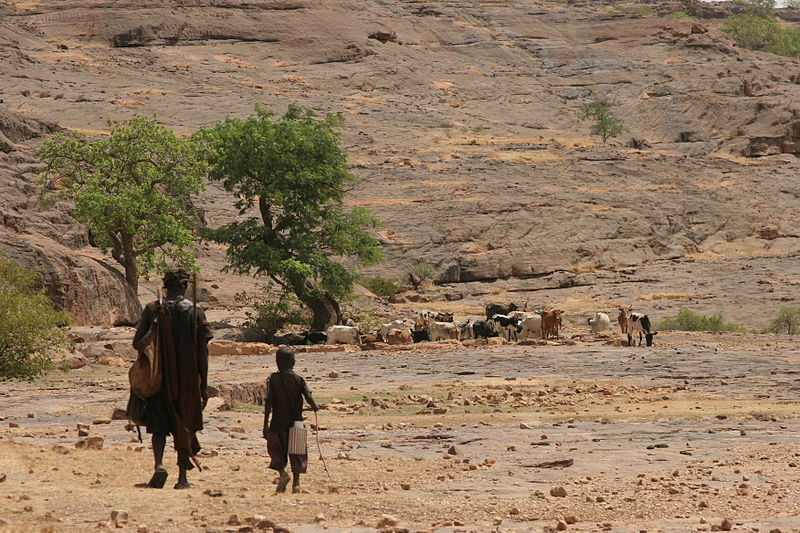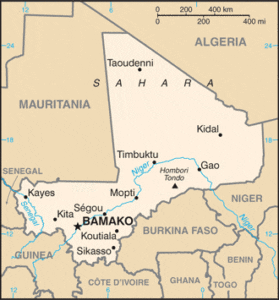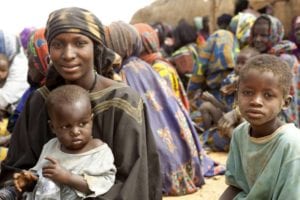 Ferdinand Reus [CC BY-SA 2.0 (https://creativecommons.org/licenses/by-sa/2.0)]
Ferdinand Reus [CC BY-SA 2.0 (https://creativecommons.org/licenses/by-sa/2.0)]
Climate Change & Ethnic Conflict in Africa Part I: Mali
This is part one of a two part series on the effects of climate change on ethnic conflict in Africa. Read part two here.
When it comes to conflict in the Sahel headlines are generally dominated by Boko Haram’s activities in the Lake Chad Basin. However, one conflict that doesn’t get as much publicity is the conflict in central Mali between the Dogon and Fulani ethnic groups.
Just last week an overnight raid, reportedly carried out by Fulanis, killed 95 Dogons as tensions between the two ethnic groups in Mali continue to rise.
A few months prior more than 160 people were killed in a village that is home to the Fulani people. The immediate cause of the raid, carried out by Dogon militias, was reportedly because the Fulani were supporting a violent preacher.
While the immediate causes of the attacks may be quite specific, such as the support for a violent preacher, climate change exacerbates the existing conditions that lead to conflict.
The conflict between the Dogon and Fulani people in Mali is a prime example of how the underlying effects of climate change can lead to conflict.
The Conflict in Mali
The Sahel region is growing less and less stable thanks to a combination of environmental and demographic factors.

Photo Credit: CIA World Factbook
Physically, the Sahel is a hot, sunny, and dry climate with limited rainfall a few months out of the year and rainfall levels vary from season to season. Traditionally the region has also been home to semi-nomadic people that have utilized the climatic differences between the drier north and wetter south for gazing.
Extremism has also taken root in the region, further complicating the security environment. Terrorist organizations, including Boko Haram and al-Qaeda in the Islamic Maghreb, have taken root in the region.
Ethnic group tensions have also flared up and led to violence, such as the conflict between the Fulani and Dogon ethnic groups.
Traditionally the Dogon people have been stationary as they practice settled agriculture. On the other hand, the Fulani people are a largely Muslim, semi-nomadic group of roughly 38 million spread over a handful of West African states, including Mali.
The conflict between the two groups in Mali has stemmed from, among other things, accusations that the Fulani people have bought their cattle onto Dogon farms and destroyed their crops.
The rise of Islamic extremism in Mali following the March 2012 coup d’état has introduced more weapons, more instability, and a less effective government to police the area. This combination of more guns and less government has led to disputes between the Dogon and Fulani being settled more with guns and less with negotiations, as was the norm in the past.
According to a spokeswoman for the UN, from March 2018-March 2019 thousands have been displaced and around 600 men, women, and children have been killed.
The Role of Climate Change in the Conflict
Much of the attention paid to conflict in Mali has centered around the coup d’état and resulting international intervention to prevent radical Islamic groups from taking root in the Sahel.
However, under the surface climate change has also played a part in the Malian conflict. The 2019 US Intelligence Community’s Worldwide Threat Assessment broadly identified climate change as a driver of conflict when it stated, “Global environmental and ecological degradation, as well as climate change, are likely to fuel competition for resources, economic distress, and social discontent through 2019 and beyond.”
Specifically, in the Sahel ICRC President Peter Maurer says, “Age-old tensions between farming and herding communities are intensifying because of climate change as the availability of usable land goes down and water sources become less reliable.”
Access to usable land has been a central issue in the conflict. Rainfall in the region is erratic, temperatures are warming 1.5 times faster than the rest of the world, and the UN estimates that 80% of farmland in the region has degraded. .
Marine General Thomas D. Walhauser, Commander of U.S. Africa Command, said in a hearing in front of Senate Armed Services Committee, “We have seen the Sahel – the grasslands of the Sahel – recede and become desert almost a mile per year in the last decade or so. This has a significant impact on the herders who have to fight, if you will, for grasslands and water holes and the like.”

Malian refugee women wait with their children to receive relief items from UNHCR in Gaoudel, Ayorou district, norhern Niger. (Credit: jhntering [CC BY 2.0 (https://creativecommons.org/licenses/by/2.0)])
Climate change isn’t the sole reason for conflict in Mali as several factors – including the presence of extremist groups – have led to conflict. However, as climate change continues to make its impacts felt in Mali, the amount of usable land will continue to drop. Reduced access to land to use, whether for settled agriculture or livestock grazing, will increase competition and conflict.






